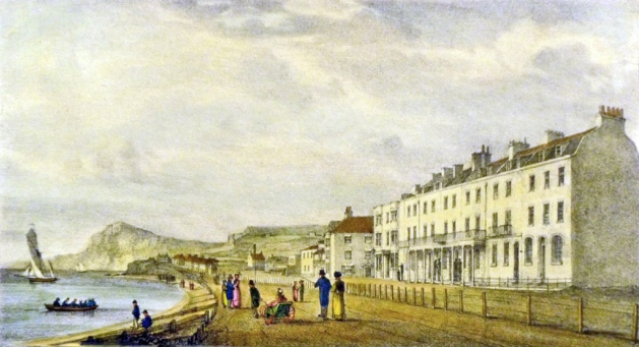WHEN AUTUMN COMES AROUND, MY THOUGHTS OFTEN TURN TO JANE AUSTEN’S FIRST PUBLISHED NOVEL, SENSE & SENSIBILITY, WHICH WAS RELEASED IN OCTOBER 1811.
As a writer, I have a tendency to immerse myself in the locations where my novels are set, so much so they often become as much a part of the story as the characters, and it was this interest that brought to mind one of the main settings of Sense & Sensibility and to ponder on why Jane chose Devon as a key location for her first novel.
It is believed the novel was originally drafted around 1795-1797, in epistolary form (written as a series of letters between correspondents, a style that was popular at the time), and was called Elinor & Marianne.
When Jane sat down to restructure the manuscript is uncertain, but it is generally thought to be after she moved to Chawton in the summer of 1809. The epistolary style had, by then, gone out of fashion, so the story was changed to a narrative structure and given the new title of Sense & Sensibility.
No manuscript exists of either version, sadly, so we can only speculate on how much the storyline changed. In the letters-style of the original, it is likely the main correspondents were Elinor and Marianne, but if so, they must have been extensively apart during the novel, which they are not in Sense & Sensibility.
My mind boggles at how daunting a re-write this must have been, but I’m also curious as to whether Devon was already a setting, or whether it was introduced during the restructuring, following the Austens’ frequent visits to the county in the early part of the nineteenth century.
Although Sense & Sensibility begins in Sussex, and diverts to London for a while, Devon is the most notable location, and it is where Jane placed Barton Cottage, the new home of Mrs Dashwood and her three daughters, ‘four miles north of Exeter’.
Barton Cottage in the 2008 TV adaptation of Sense & Sensibility by the BBC. Credit: BBC
This is the description of the Dashwoods’ first view of Barton Valley, a sight to raise their spirits after the sadness of leaving Norland:
It was a pleasant, fertile spot, well wooded, and rich in pasture. After winding along it for more than a mile, they reached their own house. A small green court was the whole of its demesne in front; and a neat wicket-gate admitted into it.
As to the area surrounding it, the Dashwoods found it favourable:
The situation of the house was good. High hills rose immediately behind, and at no great distance on each side, some of which were open downs, the others cultivated and woody. The village of Barton was chiefly on one of these hills, and formed a pleasant view from the cottage windows. The prospect in front was more extensive: it commanded the whole of the valley, and reached to the country beyond.
Amusingly, Jane describes Barton Cottage as follows:
... as a cottage it was defective, for the building was regular, the roof was tiled, the window-shutters were not painted green, nor were the walls covered with honey-suckles.
S&S Vol I Ch 6
It is well documented that Mr and Mrs Austen and their daughters enjoyed visiting the seaside and spent several holidays on the south coast, seeming to favour the West Country and, in particular, Devon and Dorset.
This love of the coast has filtered through into Jane’s novels, and there are mentions of several prominent south-coast resorts, including Brighton, Dawlish, Weymouth and Lyme Regis.
(As an aside, I highly recommend reading an entertaining chapter on this in John Mullan’s What Matters in Jane Austen, titled ‘Why is it Risky to go to the Seaside?)
On the whole, these resorts were considered respectable (although Brighton was possibly thought a little dodgy) but Jane did write to her sister Cassandra in a letter dated 14th September 1804:
“Your account of Weymouth contains nothing which strikes me so forcibly as there being no ice in the town.”
As a result of this appalling shortcoming, she jokes:
“Weymouth is altogether a shocking place I perceive, without recommendation of any kind”.
The Austens’ affection for the coast is also noted in a letter dated 25th January 1801, where Jane writes:
“Edward Cooper is so kind as to want us all to come to Hamstall this summer, instead of going to the sea, but we are not so kind as to mean to do it. The summer after, if you please, Mr. Cooper, but for the present we greatly prefer the sea to all our relations”.
And earlier that month, in a letter to Cassandra dated the 8th and 9th January 1801, Jane writes:
“Sidmouth is now talked of as our summer abode.”
A drawing of Sidmouth's Esplanade in 1826 from Tamsine’s Diary– the life and times of a Devon Gentlewoman 1808-1863. Credit: Sidmouth Museum
Sidmouth, also in Devon, seems to be a particular favourite, and Jane did pass the summer of 1801 there, along with her parents and Cassandra, whilst alterations were made to the property they had taken in Sydney Place, Bath.
There are hints of a romance for Jane during this holiday, which did not end well, as the young man concerned left the resort for a time and tragically died soon afterwards.
Little is known about this mysterious suitor beyond him being a member of the clergy, and there are no known surviving letters that make any reference to it, though some family members do seem to have been aware of it.
Did Jane’s memories of the happier days of that summer influence her decision to set her first novel in Devon? Or was it simply that she loved the West Country and her many visits were more than adequate in inspiring the setting?
Sadly, we will never know for certain, but I like to think her memories played their part.
© Cassandra Grafton - Jane Austen Literacy Foundation Literacy Ambassador, writer, and co-author of 'The Particular Charm of Miss Jane Austen'. Find her on Twitter and Facebook.
References:
Sources: What Matters in Jane Austen: John Mullan - Bloomsbury Publishing plc (2012)
Jane Austen’s Letters (4th Edition): Deirdre Le Faye - Oxford University Press (2011)
Jane Austen, A Family Record: Deirdre Le Faye - Cambridge University Press (1989)
Self-isolating, social distancing, or just in need of some reading material to relax and entertain you? You can catch up on our previous issues of Pride & Possibilities here:
Image credit: BBC




